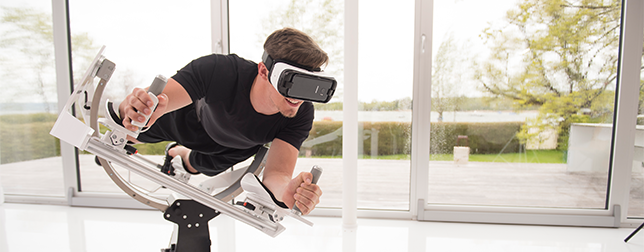Let´s be honest, every one of us likes to play videogames, at least every now in a while. But times where we sat physically inactive in front of a TV and all we did was smashing buttons luckily are a thing of the past. Nowadays, virtual reality games allow us to immerse into the gaming world and control our alter-ego by moving our bodies in the real world. Early scientific research on virtual reality tells us that it provides motivational physical activity (Harris & Reid, 2005) and that it increases enjoyment while decreasing tiredness (Plante, Aldridge, Bogden, & Hanelin, 2003).
We had a look at what´s hot in the wearable gaming sector some time ago: A World Within Ours, Wearables Are Changing The Future Of Games, New Devices For Gaming – But let´s see what´s on the horizon and let´s get active while gaming.
The German based ICAROS GmbH is combining a virtual reality head mounted display with a fully new engineered device which gave their company its name: ICAROS (see header picture). Players plank in the ICAROS and by moving and tilting their body (and consequently activating different muscles) they “fly” in the virtual reality. Applications range from racing a motorcycle, diving with a submarine or flying a jetpack-like device – all controlled by your bodies movement.
Put on your head mounted display, grab your lightsaber and may the force be with you! Lenovo and Disney have joined forces and let you immerse in the Star WarsTM Fight against Darth Vader or control the troops of the rebellion out of the control room. The future of the universe is literally in your hands now.
Cyberith Virtualizer literally lets you set foot into the VR environment allowing as much immersion in the game as currently possible. Admittingly an application for the more sophisticated gamer, the Virtualizer physical platform tracks whether you walk or run and if you stand, crouch or sit and brings these movements into different game scenarios.
When it comes to gaming in VR, it is not solely about putting your VR-Glasses on to immerse in the virtual reality – you also want to feel and touch the objects you see. Axon VR is trying to close this gap by providing tactile and thermal feedback to the user. While no gaming experience is available now, this appears to be only a matter of time. Imagine playing a boxing game where you can literally feel the punches of your opponent and hope that you are not boxing against a heavyweight-champion. Imagine skiing in the Alps and Axon VR lets you literally feel the cold snow. During summer. Right in your home.
Based in Melbourne, Zero Latency offers VR multiplayer games where you fight e.g. zombies or rogue drones. For the ones which do not like to fight, you can also transform into an ancient alien and work with your fellows to reunite with your clan from which you were separated at the start of the game. Teamwork and having fun together with your friends is key in this type of gaming, thereby combining three aspects: Gaming, physical activity and sharing quality time with your friends.
In the real world, our eyes accommodate to focus on one narrow point which becomes elucidated and sharp, whereas every other object becomes blurred. However, in the virtual reality this is currently not the case and every object (regardless if one is focused on it or not) is sharp, leaving the subject with an unnatural feeling behind. Thanks to Avegant´s Light Field technology, this could change in the future. The Light Field technology offers the visualization of objects at multiple focal planes which increases the realism of the virtual/mixed reality by sharpening objects to which the eye accommodates.
Asus as well as other hardware providers employ the freshly released Windows Mixed Reality software. The cool thing about it is that it can track motion without the need for any external video cameras as these are already build-in in the headset. These cameras directly track the motion of your controller, even if these are out of sight of the cameras – big thanks to algorithms which are based on inverse kinematics.
References:
Harris, K., & Reid, D. (2005). The influence of virtual reality play on children’s motivation. Can J Occup Ther, 72(1), 21-29. doi: 10.1177/000841740507200107
Plante, T., Aldridge, A., Bogden, R., & Hanelin, C. (2003). Might virtual reality promote the mood benefits of exercise? Computers in Human Behavior, 19, 495-509.












